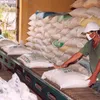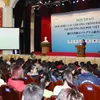Industry, trade sector urged to take on world
In a speech delivered at a conference to review the sector's activities and tasks for 2016 held in Ha Noi on Thursday, Dung underscored the great potential of the nation's domestic market of more than 90 million people.
He also requested the Ministry of Industry and Trade (MoIT) to continue its restructuring to improve the quality and competitiveness of the sector, with special attention paid to State-owned enterprises, among other tasks.
Further, he instructed the ministry to revamp regulations and policies to promote industrial production and services, to assure robust and sustainable growth.
The PM noted that free trade agreements (FTAs) could bring new opportunities to the country. The MoIT needed to promote communications so that the public and businesses could be better aware of the FTAs' opportunities and challenges. This requires detailed action plans and restructuring efforts.
"I believe that the Vietnamese people and businesses are innovative and capable of competing in international markets," he said.
He also asked the ministry to promote the movement to encourage the Vietnamese people to purchase local products, establish technical barriers, in line with international practices and commitments, while boosting administrative reforms to improve the nation's business environment.
Deputy Minister Tran Tuan Anh said Viet Nam had set a target of 10 per cent growth in exports in 2016. This means revenue from outbound shipments would reach US$178 billion next year, while the trade deficit would be kept under 5 per cent.
It planned to boost exports of processed and manufactured products, key staples and goods with high added value or notable earnings, while restricting the import of luxuries and commodities that can be made domestically.
According to the deputy minister, in 2015 Viet Nam shipped approximately $162.4 billion worth of products overseas, an annual increase of 8.1 per cent. The processing-manufacturing sector and foreign-invested enterprises contributed significantly to this growth in revenues.
Meanwhile, falling prices and reductions in quantities of agricultural produce and minerals negatively affected 2015's export turnover.
The country imported $165.6 billion worth of commodities, up 12 per cent from 2014.
A major part of imports was production materials, reflecting the considerable proportion of outsourcing in the domestic economy and the reliance on foreign suppliers, which resulted in increasing production costs and the inferior competitiveness of locally made products.
Meanwhile, the trade deficit was well controlled at two percent of export revenues, equaling $3.17 billion.
The ministry also aims for a growth rate of between 9-10 per cent in the industrial production index and a 12 per cent increase in retail and services in 2016.
Reviewing the industrial production index, he pointed to its impressive growth of 9.8 per cent, representing two percentage points higher than the yearly target. The manufacturing setor posted the highest growth at 10.6 per cent.
Integration into the global economy was a highlight of 2015. Viet Nam signed FTAs with the Eurasian Economic Union and South Korea, while concluding negotiations of the Trans-Pacific Partnership agreement and an FTA with the European Union. Consequently, Viet Nam has entered into FTAs with 55 economies worldwide, including 17 out of 20 G20 countries and all seven G7 countries.
Tags:





